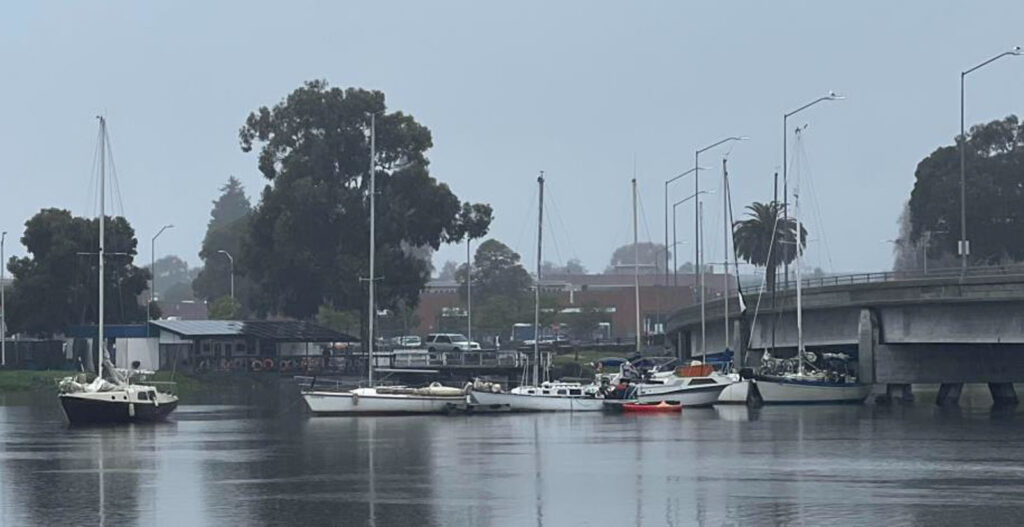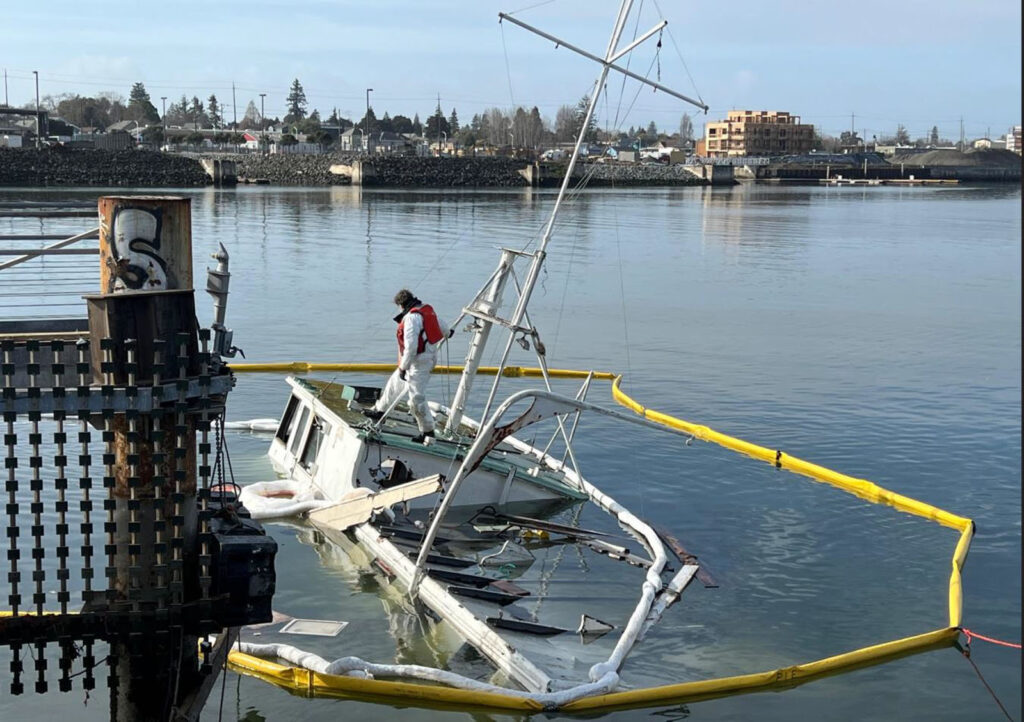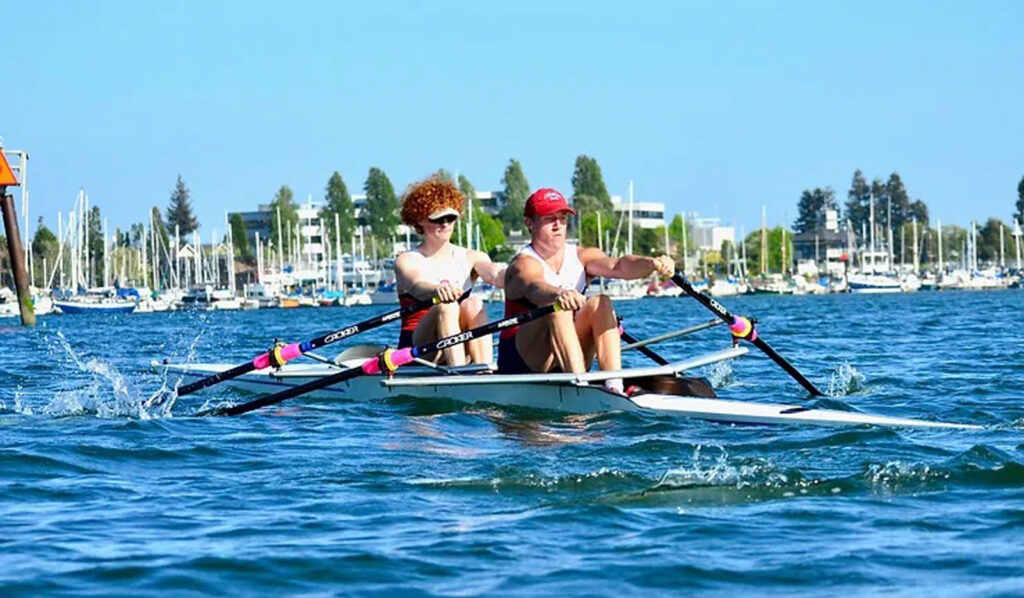In early January, heavy rain and strong winds caused several improperly secured sailboats on the Oakland-Alameda Estuary to unmoor and collide into the Coast Guard Island Bridge. According to Chief Petty Officer Levi Read, Assistant Public Affairs Officer for the United States Coast Guard’s Eleventh District, which encompasses the Western US, the sailboats scraped against but did not cause damage to the structure. CPO Read said the Coast Guard is aware of numerous abandoned vessels in the Estuary and is “actively monitoring the situation for potential environmental, navigation safety, and security concerns.”

Such assurances have done little to ease the frustration and worry of individuals who live, work, and play along the Estuary. Alameda Marina Harbormaster Eileen Zedd said the presence of abandoned vessels and anchored-out vessels—individuals illegally living aboard their boats, rent-free, on the Estuary—have “gotten out of hand” and pose a serious safety hazard.
Many of the anchored-out vessels inhabit unregistered and poorly maintained vessels that frequently leak fuel into the water. Trash, debris, and sewage are often dumped directly into the Estuary. The anchor-outs, Zedd explains, are usually not experienced mariners and lack the training to properly maneuver or secure their boats. As such, the vessels are tied to public piers or anchored haphazardly about the Estuary with little regard to navigational safety. So when the inhabitants come ashore on makeshift rafts and dinghies to restock supplies—or when they decide they no longer wish to reside on the water—the boats can unmoor and are left abandoned, drifting aimlessly with the tide.

A decade-long pileup
In fall 2013, CalRecycle, the Environmental Protection Agency (EPA), Oakland Police Department (OPD), US Coast Guard, and a host of other government agencies and local stakeholders joined forces to conduct a large-scale cleanup of the Estuary. The $7.8 million multi-agency effort was spearheaded by Brock de Lappe, who has served as Harbormaster at both Oakland Marina and Alameda Marina in the past decade. He credits a serendipitous confluence of grant funding, political will, and local support for allowing the cleanup to occur. Over 350 tons of debris and 35 truckloads of concrete were removed from the Estuary. The EPA discovered flammable liquids, waste oils, marine batteries, and various types of toxic waste in the water.

Yet clear conditions on the Estuary did not last long. Marine units from both OPD and the Alameda Police Department (APD) had to issue written and verbal warnings—sometimes months in advance—notifying anchor-outs that their vessels would be seized if they continued to dock in the Estuary or at public piers. With grant funding from the California Division of Boating and Waterways (DBW), OPD’s Marine Patrol Unit launched a smaller cleanup effort in 2019, removing and crushing as many as 10 abandoned or derelict boats.
But in late 2019, two former anchor-outs filed a lawsuit against the City of Oakland, officers of the OPD Marine Patrol Unit, and Sean Alexander Marine Services, Inc., seeking compensation for their vessels and personal property on board. The plaintiffs alleged that the City of Oakland and OPD failed to provide “adequate notice and opportunity for hearing” before OPD seized their vessels, and therefore violated their due process rights. In July 2021, the Oakland City Council authorized a $280,000 settlement of that lawsuit.
De Lappe said he believes the lawsuit sent shockwaves across law enforcement agencies, and that many appear to be engaged in a “de-facto stand down,” taking a much more hesitant approach in dealing with anchor-outs for fear of future litigation. Despite this, APD’s Marine Unit removed approximately 11 vessels from the Estuary in 2022, according to Sarah Henry, Public Information Officer for the City of Alameda. As of mid-January 2023, there were no sunken or derelict boats on the Alameda side of the Estuary, she noted. The achievement is a result of a $100,000 grant from the Division of Boating and Waterways, allowing APD to remove the vessels without tapping into City funds.
Anchored-out vessels a threat to public safety
But apparent inaction by OPD on the Oakland side of the Estuary has frustrated Marjorie Setchko, a coach who works primarily with high school and college-age rowers at the Oakland Athletic Rowing Society (OARS), located near Union Point Park in Oakland. She estimates as many as 15 anchor-outs or abandoned boats have clustered on the water in front of that park, from which the sailboats that collided with the Coast Guard Island Bridge unmoored on December 28.

OARS rowers, Setchko explained, frequently go out before sunrise and after sunset, rain or shine, to accommodate busy school schedules. In such conditions, vessels anchored willy-nilly in the Estuary can lead to potentially deadly consequences, she said, noting that her students have collided into anchored-out vessels and have capsized on numerous occasions.
“Where the boat was when the rowers launched is not always where it will be when the rowers come back,” Setchko said. This makes it near impossible for rowers to anticipate and avoid debris, anchor lines, and other obstacles in the water. After multiple pleas to law enforcement for assistance, Setchko believes agencies are just passing the buck. Meanwhile, she said, she has tried informing anchor-outs of the dangers they pose and suggesting they relocate closer to shore, but they have ignored, threatened, or cursed at her.
These kinds of responses are nothing new to Harbormaster Eileen Zedd, who said batteries, motors, and even dinghies have been stolen from her tenants at Alameda Marina by anchor-outs. “They live under the radar, and many think they are above the law,” Zedd said. “The water has become sort of a hiding place for vagrants and crime.”
The road ahead
Greg Scharff, General Counsel for the San Francisco Bay Conservation and Development Commission (BCDC), the organization in charge of protecting and enhancing the Bay, said that BCDC and state law prohibit living on the water—with certain notable exceptions, including marina houseboats. But many choose to do so anyway, especially amidst the housing shortage and affordability crisis plaguing California. The situation has drawn comparisons to homeless encampments or RV parking on city streets, but the environmental and safety implications of anchored-out vessels involve additional dangers.
Ultimately, BCDC has the authority to fine cities for failing to clean up anchored-out vessels and other debris on waterways within their city boundaries. BCDC recently developed a controversial plan to remove all anchor-outs from Richardson Bay in Marin County by 2026. But Scharff recognizes that homelessness is a major issue in the Bay Area and notes that BCDC is working “in good faith” with Oakland and Alameda to mitigate cost and identify a softer approach, whatever that may be. Scharff expressed uncertainty as to whether another full-scale cleanup is the best option, but ruled out the suggestion of designating specific anchor zones on the water where all anchor-outs could relocate.
De Lappe, on the other hand, said another Estuary cleanup effort is critical and must be followed by regular patrols from fully funded and staffed marine units to ensure the problem does not worsen again. He also suggested modifying state law to allow marinas—not just local law enforcement—to apply for DBW grant funding. Harbormasters, he argued, have the ability to nip the issue in the bud by identifying and removing neglected boats tied down in marinas and public piers before they become derelict. Once they sink into the water, they become much more resource-intensive to remove, he noted.
BCDC’s Enforcement Committee will receive an update on the issue at its February 22 meeting. In the meantime, de Lappe offered a clear message for local agencies: “Those responsible must act responsibly.”
Neither the City of Oakland nor the Oakland Police Department responded to the Post’s requests for comment on this story.
Ken Der is a contributing writer for the Alameda Post. Contact him via [email protected]. His writing is collected at AlamedaPost.com/Ken-Der.



